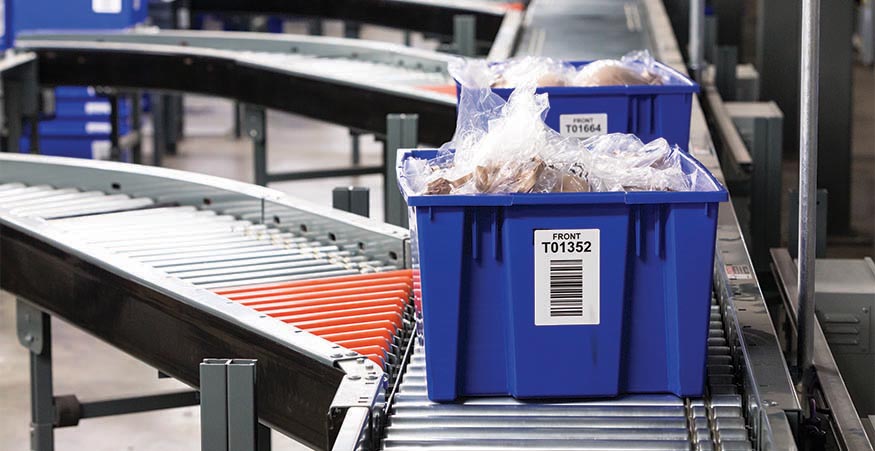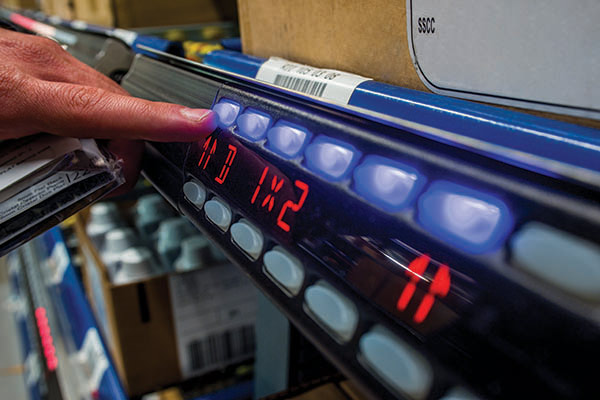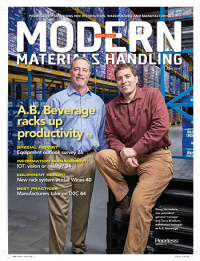Made From Scratch: Manufacturers set sights on direct-to-consumer (D2C) fulfillment
A predictable fold in the supply chain sees more manufacturers - at the behest of their top retail customers -pursuing direct-to-consumer fulfillment capabilities, a trend that is as challenging as it is rewarding.
Manufacturers have historically built their distribution around large quantities of finished goods. They build pallets or mixed pallets, store things in pallet rack, and ship to distributors or stores for presentation to consumers.
These operations are in no way suited to e-commerce fulfillment processes, and yet more and more manufacturers are facing pressure to embrace them. Big box retailers and other large customers have plenty of leverage to demand that their suppliers jump into the direct-to-consumer (D2C) game, and those retailers need all the help they can get as their own networks pivot to address the challenge.
“It’s a big concern,” says Norm Saenz, managing director at St. Onge Co. “This e-commerce push has taken off and has really made an impact in the last couple of years. It’s not stopping, and it’s hitting everybody, including manufacturers. It’s kind of hard for them to say no to their top customers, and if they do it right, it can be a revenue generator.”
Manu-fillment
The conditions and requirements for e-commerce fulfillment vary widely from one manufacturer to the next. Saenz says some companies have lost one piece of their business as e-commerce has risen to fill that space. Others are surviving solely from e-commerce business.
“Some companies have a natural shift from mostly retail to mostly e-commerce, and what was once 75/25 has flipped the other way,” Saenz says. “In that case, they can reconfigure the space they have. But even if they’re still mostly shipping to stores, those retail shipments are getting smaller and the whole dynamic has changed. Where they used to fill totes with 20 units, now it’s two or three, and there are 10 times as many totes.”
The good news is that manufacturers can draw upon the innovations of recent years and the lessons distributors have learned from their journeys toward omni-channel capabilities. Saenz says put walls, for example, have emerged as a great way to batch pick and put single-line orders in a small, efficient space.
“Previous to put walls, you would need a separate forward pick area,” Saenz says. “Now you can set up an e-commerce environment in a small space and potentially use the same inventory. It’s a real popular way of handling this new demand.”
Third-party logistics (3PL) providers are another common way to meet the challenge. That said, having recognized the inevitability of e-commerce growth, many manufacturers who are leaning on 3PLs have plans to ultimately bring fulfillment in-house, according to Bryan Duncan, senior account executive for Daifuku Wynright.
“A large part of the market is served by 3PLs, which are growing and will continue to play a large role,” Duncan says. “But a lot of manufacturers want to have the control to maintain or increase margins. The tools are in hand and more available now than ever. You might have mindsets that are resistant to change, but it’s already taking place.”

Share and share alike
It seems only fair that manufacturers are now borrowing solutions from distributors given the last decade’s migration of technology in the other direction. Having proven to be valuable tools for e-commerce fulfillment, relatively simple technologies like voice, pick-/put-to-light and mobile robotics are being embraced by manufacturers.
“Those technologies used downstream are now moving upstream,” says Chris Arnold, vice president of operations and solutions development for Honeywell Intelligrated. “There are very simple technologies a manufacturer can use for pick, pack and ship, and they’re not significantly disruptive.”
For example, a large consumer packaged goods (CPG) manufacturer might need to dedicate an area to e-commerce. To minimize disruption, they might deliver pallet or case quantities to the new e-commerce area in the same way they would to any other customer. Because manufacturers typically don’t handle tens of thousands of SKUs like DCs, a dedicated e-commerce fulfillment associate can then process individual orders from the limited range of SKUs.
This design pushes costs upstream and eliminates multiple touches required in the traditional supply chain, Arnold says. But this is not only a burden to the manufacturer—it’s an opportunity. Every manufacturer has an interest in preserving their brand and presentation to the consumer, and building D2C competence is an ideal way to maintain brand image while supporting the brand of downstream retail partners.
“In the past all they did was manufacture goods and pass the brand image to a distribution client who at that point began representing the brand on shelves or online,” Arnold says. “Now, the CPG actually gets to help with the image of their product. This also allows the manufacturer’s clients and distribution/fulfillment partners to have an open and collaborative discussion about what is the best way to serve product through the service portal. This will continue to enhance the supply chain overall because communication will get better.”
That said, the very idea of having a pick module is new to most manufacturers, Saenz says. Fulfillment will compel them to think creatively about the use of vertical space, potential mezzanines, storage media like case flow and shelving, and the strategic use of conveyor to reduce the labor required to transport goods.
“A lot of traditional automation is going to make a big difference for manufacturers who are manual,” Saenz says. “Their methods have served them well in the past, but they will have to be much more precise about how they manage their business to meet changing requirements.”
Surfing the e-commerce wave
That precision includes identifying SKU dimensions and characteristics to efficiently size storage locations and automation specs.
“Get control of your inventory levels and start thinking about how to use your space more effectively,” Saenz advises. “If the e-commerce wave comes crashing down on you, you will need space. You might not be able to get away with the level of technology you used when you had space. You’ll need to be more precise with data and dimensions to be able to use the automation that can help you.”
Saenz says basic capabilities like whether a warehouse management system (WMS) supports batch picking can be a big handicap to a manufacturer’s fulfillment aspirations. If a manufacturer is accustomed to big orders, it will benefit from batching and waves instead of trying to mix single-line orders with big ones. This is where warehouse control systems (WCS) or warehouse execution systems (WES) can provide some of the functionality a WMS lacks and will facilitate options like conveyors or put walls.
As a manufacturer ramps up from purely manual operations, Duncan suggests automation will become essential at about 5,000 lines of each picks per day. Beyond 10,000 to 15,000 lines, solutions like shuttles or unit sortation systems might come into play. Even in a largely manual environment, however, automation like a pallet load automated storage and retrieval systems (AS/RS) could help a manufacturer free up space for fulfillment operations while using the same inventory for both wholesale and D2C orders, Duncan says. WES are also indispensable to these sorts of hybrid manual/automated systems.
“A WES reaches upstream and downstream, and knows where inventory is and what’s available,” Duncan says. “Using a common inventory instead of the often troublesome ‘DC within a DC’ is becoming more doable and common with a robust WES. It provides responsiveness and visibility at your fingertips. You don’t have to go from one system to another and hope that what’s available in inventory for one is the same for another. The WES sees it all.”
Still, Duncan says the successful e-commerce manufacturer will find the transition is less about the automation and more about leadership. “Once you decide to do it, it’s a commitment issue,” he says. “Big change management is probably the biggest challenge. Make sure everyone is on board, there’s no pushback upstream, and you carve out both the physical and organizational space for it.”
Arnold agrees, and encourages manufacturers on this journey to leverage the consultants, vendors and system suppliers with the knowledge and a plan. “They know how to involve all senior leaders to make sure production, sales, finance, warehousing and all stakeholders know how to support the market need,” Arnold says.
For example, manufacturing experts know how to get eaches into a case and onto a pallet, and experts from the distribution space know that when the pallet arrives they take cases off, cut them open and pick.
“So maybe it’s best to tap into eaches on the manufacturing line and route them to e-commerce, D2C fulfillment. Or maybe it’s best to take a case, or a layer, or a full pallet,” Arnold says. “Whatever it is, we want to identify the opportunity to send product off to the side for processing that will have a minimal impact.”
The right approach will be different for everyone, and Arnold cautions against the desire to copy what works for someone else. “They have to find a way to bridge the gap from where they are to where they need to get to,” he says. “It’s critical to do that before the e-commerce wave crashes on you.”
Companies mentioned in this article:
Article Topics
Inventory & Picking News & Resources
Siemens, Universal Robots, and Zivid partner to unveil smart robotic picking solution AI-based inventory monitoring solution provider Gather AI raises $17 million NRF 2024 retail sales forecast calls for growth Swisslog gives live demonstration of ItemPiQ latest evolution Cimcorp automates fresh food distribution with flexible storage, order picking solutions ABCO Systems acquires FastFetch The Ultimate Guide to Reducing Warehouse Travel More Inventory & PickingLatest in Materials Handling
Registration open for Pack Expo International 2024 Walmart chooses Swisslog AS/RS and software for third milk processing facility NetLogistik partners with Vuzix subsidiary Moviynt to offer mobility solutions for warehouses Materials Handling Robotics: The new world of heterogeneous robotic integration BSLBATT is looking for new distributors and resellers worldwide Lucas Watson appointed CSO for Körber’s Parcel Logistics business in North America Hyster recognizes Dealers of Distinction for 2023 More Materials HandlingAbout the Author
Subscribe to Materials Handling Magazine

Find out what the world's most innovative companies are doing to improve productivity in their plants and distribution centers.
Start your FREE subscription today.
April 2024 Modern Materials Handling

Latest Resources













